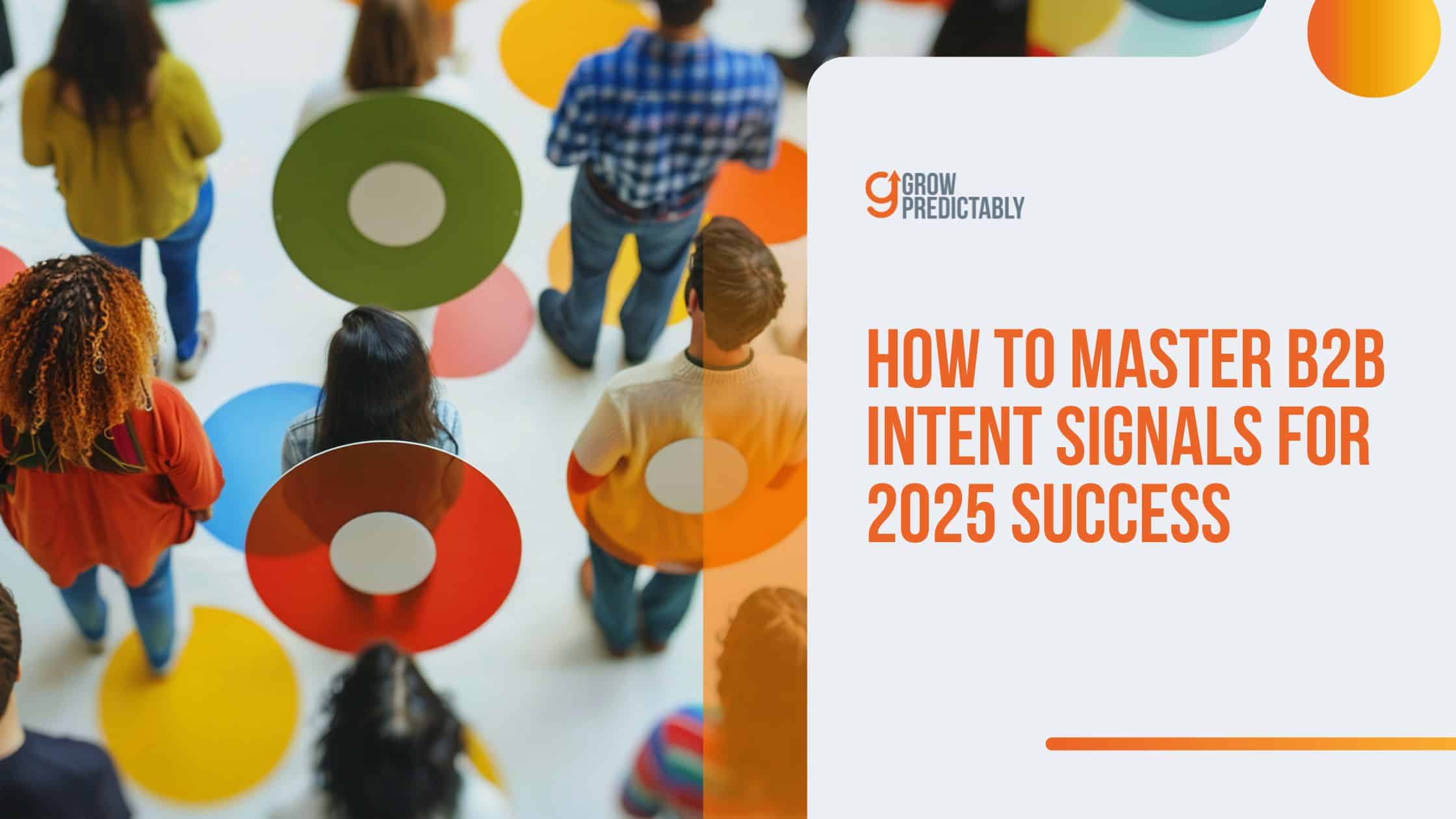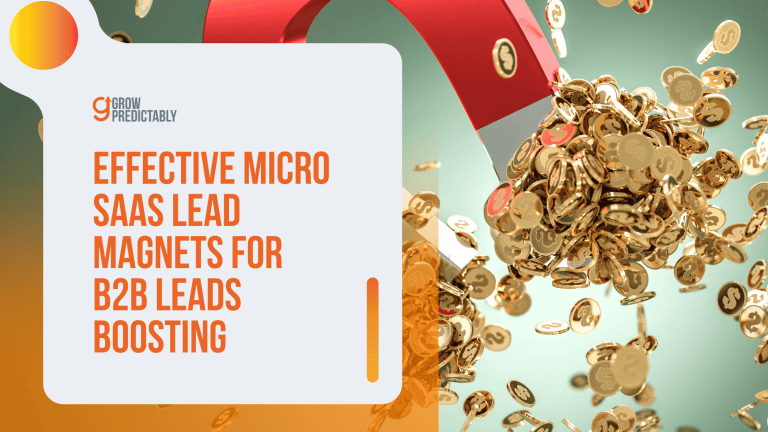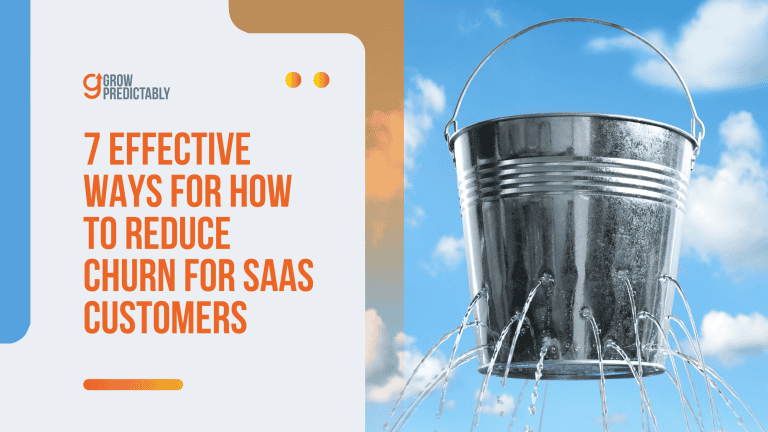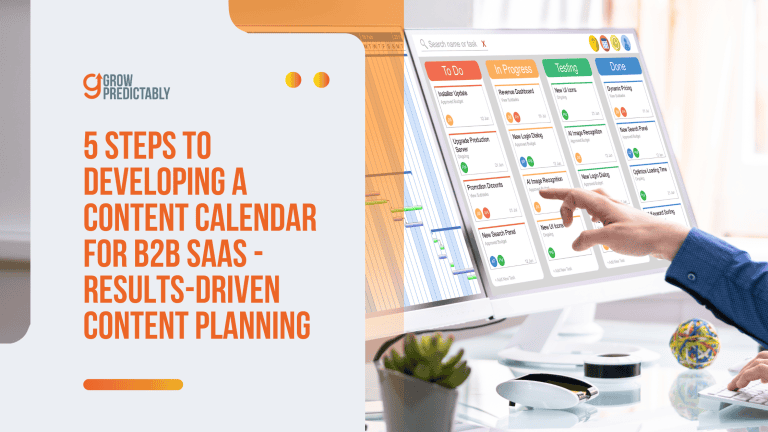How to Master B2B Intent Signals for 2025 Success
Have you been feeling left behind because you just can’t figure out how to use B2B intent signals like your competitors?
Guess what, you’re definitely not alone!
It’s a common struggle for many businesses.
Here’s something interesting: 55% of sales leaders saw improved lead conversions when incorporating intent data into their strategies.
Knowing how to read these signals can totally transform your business.
Stick around and you’ll learn all the tips you need to turn B2B intent signals into your business’s secret weapon for 2025.
Let your curiosity take the lead!
Understanding B2B Intent Signals
The difference between 7-figure businesses and 8-figure businesses isn’t magic—it’s data.
Specifically, intent data.
While your competitors are chasing cold leads, you could be closing deals with prospects who are already shopping for solutions like yours.
B2B intent signals aren’t just marketing jargon.
They’re digital footprints your future customers leave everywhere, signaling they’re ready to buy before they ever fill out your contact form.
According to TrustRadius, 87% of buyers want to self-serve part or all of their buying journey—meaning most decisions happen before anyone talks to your sales team (Source).
And the payoff? Buyer intent data provides actionable insights into customer behavior and enhances conversion rates, helping companies see 3x higher conversion rates on average (Source).
Breaking Down the Signals
Intent signals fall into four categories that give you X-ray vision into your prospect’s buying journey.
Each category reveals a different dimension of purchase readiness.
1. Engagement Signals
These are the digital equivalent of someone walking into your store and trying out your products.
When prospects engage deeply with your content, they’re raising their hand—sometimes without even realizing it.
- Webinar attendance: Someone investing 45 minutes watching your webinar isn’t just killing time
- Email click-throughs: Especially on product-specific or bottom-funnel content
- Time spent on pricing pages: Visits to the pricing page are a critical touchpoint in understanding customer intent and engagement, akin to asking “how much?”
Track these systematically and you’ll spot purchase intent patterns before competitors even realize there’s an opportunity.
2. Research Signals
Research signals show prospects actively comparing solutions.
They’ve identified their problem and are evaluating options—including yours.
According to Gartner, B2B buyers spend 27% of their time researching independently online (Source).
- Product comparison page visits: They’re literally putting you side-by-side with alternatives
- Specific search queries: Searches like “[your product] vs [competitor]” or “[your product] pricing”
- Content downloads: Especially technical documentation, case studies, or implementation guides
These signals let you tailor your outreach to address exactly what prospects are considering right now.
3. Technographic Signals
Your prospect’s tech stack tells you everything about their pain points and compatibility needs.
It’s like knowing what’s in someone’s garage before offering them car accessories.
When a company adds Salesforce to their stack, they’ve just created a dozen new problems they’ll need to solve.
If your solution integrates with Salesforce, that’s your opening.
According to Intricately, companies invest in 3-5 complementary tools within six months of adopting a major platform (Source).
4. Company Event Signals
Major company events create buying windows that most salespeople miss.
These are moments when budgets loosen and new priorities emerge.
Recent funding rounds mean new capital to invest in growth tools.
New job postings indicate expanding teams that need systems and software.
Mergers and acquisitions create integration challenges your product might solve.
Companies that raised funding increase their software spending by 55% in the following year (Source).
Benefits of Using Intent Data
Intent data demolishes the traditional marketing-sales divide.
Instead of marketing passing lukewarm leads to frustrated sales teams, both departments operate from the same playbook—actual customer behavior.
This alignment fosters a more strategic approach to B2B sales, enhancing conversion rates and streamlining workflows by ensuring that both teams are focused on the most relevant aspects of their offerings.
According to Forrester, organizations with aligned sales and marketing teams achieve 24% faster revenue growth and 27% faster profit growth over a three-year period (Source).
When your teams see the same signals, they stop fighting and start closing.
The ROI impact is immediate and measurable.
Companies using intent data see 79% higher conversion rates than those who don’t (Source).
Lead scoring helps in prioritizing sales and marketing efforts by evaluating leads based on their intent signals and alignment with the ideal customer profile (ICP).
This strategic approach emphasizes optimizing resource allocation to enhance conversion potential.
Your sales cycle doesn’t just improve marginally—it transforms completely.
Imagine your reps spending time exclusively with prospects already showing buying signals rather than cold-calling uninterested accounts.
- Precision targeting: You’ll finally stop burning money and time on leads that go nowhere. Instead, you focus resources on accounts showing actual purchase intent, multiplying your efficiency.
- Personalized outreach: Your sales messages hit differently when they address exactly what the prospect was just researching. This isn’t generic personalization—it’s responding directly to their recent actions and interests.
- Competitive advantage: When a prospect is comparing you with competitors, intent data lets you jump in at exactly the right moment with exactly the right differentiators. You’re not just selling—you’re answering the specific questions they’re asking right now.
- Higher close rates: Your best salespeople spend their time exclusively on prospects who are already in-market, not convincing reluctant buyers. This concentrates your firepower where it actually matters.
The resource efficiency alone justifies the investment. Intent-driven companies achieve 28% lower customer acquisition costs while improving conversion rates (Source).
Every marketing dollar works harder because you’re targeting prospects already showing interest in solutions like yours.
This efficiency compounds over time as your teams get better at interpreting and acting on intent signals.
Intent data transforms the customer experience from annoying to helpful.
Instead of bombarding prospects with generic pitches, you enter conversations with context about their specific challenges.
This builds trust, shortens sales cycles, and creates the foundation for expansion revenue after the initial sale.
Using the Growth Scorecard to Track Intent
The Growth Scorecard is a dynamic performance tracking tool that helps businesses measure progress across each stage of the customer journey.
It’s not just another static report—it’s a living document that uses color-coded metrics (red, yellow, green) to instantly visualize where you’re excelling and where you’re falling short.
Unlike traditional reporting that happens monthly or quarterly, the Growth Scorecard demands weekly tracking to catch issues before they become disasters.
Each metric has an assigned owner, creating accountability and turning data into action.
Intent signals become infinitely more valuable when systematically tracked and measured through your Growth Scorecard.
Without this framework, your intent data is just interesting information rather than a revenue-driving asset.
The scorecard turns scattered signals into a structured assessment of your readiness to capture buyers showing interest.
Track your response to these signals across four stages:
🔴 Red: No system to capture/respond to signals. You’re essentially flying blind while competitors are using radar. Your sales team is prospecting based on intuition rather than data, resulting in wasted efforts and missed opportunities.
🟡 Yellow: Basic tracking but slow response. You see the signals but your processes move too slowly to capitalize. By the time your sales team reaches out, the prospect has already talked to three competitors and formed opinions without your input.
🟢 Green: Automated tracking and quick action. Your systems immediately flag intent signals and trigger the appropriate response—whether that’s sales outreach, targeted content, or personalized ads. This creates a seamless experience that meets buyers exactly where they are in their journey.
The difference between yellow and green is often just 24-48 hours, but those hours can determine whether you win or lose the deal.
According to InsideSales research, companies that contact prospects within 5 minutes of a signal are 100x more likely to connect than those who wait an hour (Source).
Top 5 B2B Intent Signals
Understanding which B2B intent signals to track can be a game-changer for your sales strategy.
These signals help you focus on the prospects that are most likely to make a purchase, saving you time and boosting your effectiveness.
By understanding your target audience, you can enhance your marketing efforts and craft personalized content that resonates with them.
1. High-Intent Page Visits
Web pages visited by potential buyers can reveal how close they are to making a purchase.
When someone views your security and compliance pages, they’re digging into the details that matter most before committing.
These kinds of visits show they’re not just kicking the tires; they’re serious about what you offer.
The same goes for visits to your pricing pages; people looking at costs are probably lining up your offer against their budget or comparing you to competitors.
How to work these insights to your advantage:
- Identify Warm Leads: Use analytics to pinpoint visitors who are serious buyers.
- Craft Customized Follow-Ups: Send tailored messages that address specific interests and concerns.
- Optimize Key Pages: Fine-tune these pages to make decision-making easier and quicker.
- Enhance Marketing Efforts: Leverage intent data and techniques like lead scoring to prioritize sales activities, transform data into actionable insights, and optimize marketing strategies for better conversion rates and overall success.
According to HubSpot, 47% of consumers check out 3-5 pieces of content before reaching out to your sales team.
These insights can help you know exactly when to make your move.
2. Hiring Activity
Looking at the job postings of your target companies can be incredibly revealing.
When businesses post new jobs, it often highlights areas they want to grow or improve.
Filling roles like sales engineers or IT specialists might indicate they’re preparing for expansion, needing new tech, or revamping internal systems.
This gives you a sneak peek into areas they might need help with, making it a golden opportunity for sales teams.
Working with hiring data can enhance your sales strategy:
- Detect Growth Areas: Understand where a company is investing and align your services accordingly.
- Targeted Outreach: Approach companies with solutions that fit their newly identified needs.
- Anticipate Demand: Offer services that complement their growth or transition phases.
Job growth often correlates directly with business expansion, highlighting why staying informed is crucial.
Check back with sources like Statista for trends that align with your target market’s moves.
3. Interactive Demo Engagement
Interactive demos stand out as strong indicators of purchasing intent.
When prospects engage with these demos, it shows they’re moving beyond basic curiosity into genuine interest.
Placing these demos on high-impact pages can boost your conversion rates.
By tracking how people interact with them, you can gain invaluable insights into what resonates with your audience, offering your sales team clear directions on addressing potential customers’ needs.
Here’s why interactive demos are vital for engagement:
- Increase Participation: Allow users to experience your product first-hand.
- Enhance Insight Gathering: Analyze user interactions to refine sales pitches.
- Clarify Customer Needs: Identify what features hold the greatest appeal or cause friction.
A Content Marketing Institute study notes that 68% of B2B marketers view demos as crucial to their strategy, underscoring their importance for nurturing interest into sales.
4. Champion’s Job Change
When a key advocate for your product at a target account changes jobs, it’s a moment full of both risks and opportunities.
Such transitions can shift a company’s priorities, so keeping track helps you anticipate what might come next.
This signal is less about the immediate impact and more about maintaining your foot in the door.
Explore how you can turn this change into an opportunity to solidify or even expand your business with them.
Here’s how to navigate job changes effectively:
- Maintain Relationship Momentum: Quickly establish connections with the new key players.
- Leverage New Dynamics: Explore upselling or cross-selling opportunities as the company reshuffles its priorities.
- Be Adaptable: Stay flexible and ready to offer solutions that align with the evolving landscape.
With job mobility constantly on the rise, as Zety indicates that 65% of employees are on the lookout for new roles, it’s a signal that should always be monitored.
5. Technographic Data
Understanding your prospects’ tech environment helps you tailor your approach.
By knowing what tools they currently use, you can pinpoint where your product fits in, whether as a replacement or an enhancement.
Technographic data offers a treasure trove of insights; knowing a potential client’s tech stack can reveal the best opportunities for you to position your product.
Understanding the distinction between first-party and third-party intent data is crucial for effectively leveraging customer intent.
Integrating technographic data into your sales strategy offers several benefits:
- Identify Product Fit: Highlight how your solutions can work with or improve their existing technology.
- Offer Upgrades: Pitch features that bring forward innovation compared to their current tools.
- Spot Trends: Understand which technologies are gaining traction in your target markets.
Gartner’s research indicates that 73% of companies rely on more than five software solutions, which shows the vast potential for integrations and upgrades.
Keep these statistics in check as you identify prospects ripe for your offerings.
By weaving these intent signals into your sales operations, you’re set to target prospects more effectively, ensuring your efforts lead to fruitful relationships and closed deals.
How to Use Intent Signals Effectively
Making the most of intent signals involves laying a solid data foundation, deriving actionable insights, and creating efficient workflows.
Let’s delve into how these elements can strengthen your go-to-market strategy and improve your outcomes.
Data Foundation
A robust data foundation is key to executing a winning go-to-market strategy.
It’s about weaving intent data with demographic, firmographic, and technographic data to get a full 360-degree view of your prospects.
Combining these data points gives you a complete understanding of every account in your total addressable market.
This approach lets you tailor your tactics to the unique characteristics of each account, enhancing your chances of success.
To build this strong foundation:
- Integrate Multiple Data Types: Blend demographic, firmographic, and technographic data to enrich your data platform.
- Holistic Market View: Develop a comprehensive map of your addressable market, identifying key prospects.
- Data Consistency: Ensure your data is up-to-date and accessible to all relevant teams to maintain clarity and direction.
By establishing a solid data foundation, your organization can support modern marketing strategies that markedly improve engagement and conversion rates.
Actionable Insights
It’s one thing to collect data, but it’s another to turn that data into clear, actionable insights.
The aim is to use these insights to orchestrate meaningful conversations that lead to sales conversions.
Intent signals can prime you to develop highly targeted marketing campaigns that resonate deeply with your audience.
They enable sales teams to prioritize and target accounts with the highest likelihood of closing, making every interaction count.
Here’s how to leverage these insights:
- Targeted Campaigns: Craft marketing strategies that speak directly to the needs and interests of your prospects.
- Sales Prioritization: Allocate resources and efforts towards accounts showing the strongest buying signals.
- Drive Meaningful Interactions: Use insights to guide conversations, offering solutions tailored to specific pain points.
According to B2B marketing research, companies utilizing these insights effectively can increase conversion rates by up to 202% source.
Workflows and GTM Plays
Enhancing efficiency in your go-to-market strategy can drastically impact your output, and that’s where intent-driven workflows come into play.
By constructing workflows based on accurate intent data, you can boost both your productivity and operational scalability.
GTM Plays enable your team to engage prospects precisely when they’re primed to buy, maximizing the impact of your efforts.
Utilizing a marketing automation platform to deliver personalized content to leads based on their interests can further enhance engagement and address specific pain points through tailored workflows.
Key benefits and strategies for workflows and GTM plays include:
- Increased Automation: Use workflows to automate routine tasks, freeing up your team for strategic work.
- Enhanced Productivity: Streamline processes to increase efficiency and reduce manual errors.
- Perfect Timing: Engage leads when they’re most responsive, improving the chances of successful conversions.
By utilizing these workflows and GTM plays, you ensure that every move in your strategy is both timely and relevant, optimizing your overall efficiency and effectiveness in the marketplace.
Incorporating these elements within your B2B approach allows you to capitalize on intent signals, translating them into results that empower your sales and marketing teams to close more deals with precision.
Tools and Platforms for Leveraging B2B Intent Signals
The right intent tools transform your Growth Scorecard from red to green almost overnight.
Without them, you’re leaving money on the table with every marketing dollar spent.
These platforms don’t just collect data—they convert signals into revenue.
Most businesses waste 40-60% of their ad spend on accounts that aren’t actively buying.
Intent tools fix this leak in your budget by focusing your efforts exclusively on companies showing purchase signals.
According to TOPO Research, organizations that leverage intent data convert leads at 3x higher rates than those that don’t (Source).
Key Tools and Platforms Needed
When you’re choosing tools to work with intent signals, you want them to do more than just gather data.
They should help you understand and use this data to your advantage.
Look for:
- Data Gathering: Tools that bring together information from all over to give a complete view of what your prospects are up to.
- Smart Predictions: Platforms that can spot patterns and suggest what to do next, so you can stay ahead.
- CRM Compatibility: Make sure the tools can easily hook up with your existing CRM for smooth operations.
- Ease of Use: Choose tools that anyone on your team can use right away without much training.
- Growth-Friendly: Pick solutions that can expand alongside your business, handling more data as you grow.
Top 5 Intent Data Providers
When integrated with your Growth Scorecard, these tools provide the data you need to accurately track your progress from red to green across all stages of intent signal response.
Let’s take a look at each:
➡️ 6sense
6sense helps you figure out which potential customers are close to making a purchase by using artificial intelligence.
It transforms anonymous digital signals into useful actions, helping you target the right accounts.
6sense costs can start around $60,000 per year, but prices vary based on needs.
Here’s what you get:
- AI insights to understand buyer behaviors.
- Predictive analytics to focus on high-value prospects.
- Tools that help sales and marketing teams work together seamlessly.
With 6sense, you’re actively focusing on leads with the highest potential, maximizing your efforts.
➡️ Bombora
Bombora is great for capturing interest data across the web, pulling info from multiple sources to see what prospects are researching.
Pricing varies widely, often starting at $30,000 annually.
Bombora helps you:
- Gain a comprehensive view through a rich data ecosystem.
- Integrate smoothly with your marketing tools for continuous data flow.
- Stay updated in real-time to quickly adjust your strategies.
Bombora ensures you’re always tapping into the market’s pulse, engaging prospects as their interest peaks.
➡️ Demandbase
Demandbase aims to completely transform how you approach account-based marketing using smart AI to refine target audiences.
Pricing can range from $50,000 to $100,000 per year.
Demandbase offers:
- Targeting precision to engage high-intent accounts effectively.
- AI-driven tools that adapt to buyer behavior instantly.
- Deep dive analytics for better strategic moves.
With Demandbase, your campaigns are spot-on, addressing the precise needs of potential buyers.
➡️ ZoomInfo Intent
This tool adds an extra layer of intelligence to your sales processes by offering details on buyer activities to help focus your efforts.
Basic pricing can start around $10,000 annually.
Key features include:
- Detailed data analysis to find high-value leads.
- Advanced targeting with integrated intelligence.
- Automation boosting speed and efficiency in responses.
ZoomInfo Intent shows which prospects are worth your time, turning leads into meaningful conversions.
➡️ Terminus
Terminus stands out in account-based marketing by using intent signals to guide strategic actions.
Prices can start at $30,000 per year, based on specifics.
It focuses on:
- Clear, detailed intent data for targeted marketing.
- Easy integration with existing systems for coordinated execution.
- Creating direct, focused engagement strategies.
Terminus helps turn data into actionable plans, ensuring every interaction moves you closer to conversion.
| Tool | Key Features | Benefits | Starting Cost* |
| 6sense | AI insights, predictive analytics, team collaboration | Target high-value leads, maximize efforts | $60,000/year |
| Bombora | Rich data ecosystem, integration, real-time updates | Stay market-informed, timely strategies | $30,000/year |
| Demandbase | Precision targeting, AI tools, deep analytics | Engage effectively, adapt campaigns | $50,000/year |
| ZoomInfo Intent | Data analysis, advanced targeting, automation | Focus on high-value leads, efficiency in processes | $10,000/year |
| Terminus | Intent data, system integration, focused engagement | Create targeted plans, action-driven interactions | $30,000/year |
These costs are estimates, and pricing may vary based on specific business needs and scale.
FAQs
Turn Traffic into Revenue!
We’ve walked through the what, why, and how of B2B intent signals—now it’s time to put theory into practice.
You’ve seen how the Growth Scorecard highlights your weak spots and how prioritizing the right tools and strategies can lead to real revenue.
Where most SaaS companies falter is not in data collection but in action.
Getting your teams on the same page, filtering noise from value, and acting fast separate the growth stage from stagnation. 💥
Are you turning digital breadcrumbs into buyer momentum—or just collecting dust?
In a world where AI gets smarter and buyer journeys more complex, selling to people already looking for you isn’t just efficient—it’s essential.
You’re not just collecting signals.
You’re collecting your next customers.








